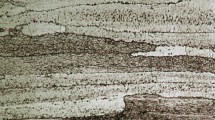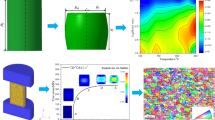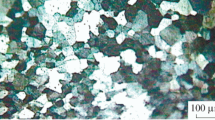Abstract
The hot deformation behavior of the Al-Zn-Mg-Cu alloy was studied by isothermal tensile tests in the temperature range of 200–350 °C and the strain rate range of 0.001–0.1 s−1. A data-driven deep neural network (DNN) constitutive model and a phenomenological Arrhenius constitutive model were developed for the studied alloy model. The parameters of the DNN model were optimized to improve the prediction accuracy of flow stress. The results show that the accuracy of predictions of the DNN model is better than the Arrhenius model for the hot deformation behavior of 7075 aluminum alloy. The average absolute relative error and correlation coefficient of the DNN model is 1.70 % and 0.9996, respectively. The accuracy of the constitutive model of Arrhenius is relatively low for 7075 aluminum alloy in the range 200–350 °C, 0.001–0.1 s−1. The optimal network depth and the number of neurons per layer for the analytically optimized DNN constitutive model are 6 and 28, respectively. In addition, the developed DNN model can be effectively applied in intelligent manufacturing, such as short-process high-efficiency hot stamping and other plastic-forming technologies.
Similar content being viewed by others
Abbreviations
- σ :
-
True stress
- Z :
-
Zener-holloman parameter
- ε :
-
True strain
- ̇ε :
-
Strain rate
- Q h :
-
Activation energy
- T :
-
Absolute temperature
- R I :
-
Universal gas constant (8.31 Jmol−1·K−1)
- N :
-
Number of samples
- x input :
-
Input data
- x input :
-
Output data
- W :
-
Weighting matrix
- b :
-
Offset vector
- E :
-
Loss function
- e :
-
Error signal
- f :
-
Activation function
- θ :
-
Parameters matrix
- X :
-
Input characteristic matrix
- R :
-
Output characteristic matrix
- σ E :
-
Experimental stress
- σ P :
-
Predicted stress
References
Y. Liu, R. Zhang and J. Zhang, An introduction of aluminum alloy casting in aircraft structure, Applied Mechanics and Materials, 529 (2014) 79–83.
L. J. Hang, The characteristic classification and development prospect of aluminum and aluminum alloy special precision extrusion materials, Aluminium Fabrication, 6 (2018) 10–12+22.
Y. Wang, X. Zeng, H. Chen, X. Yang, F. Wang and L. Zeng, Modified Johnson-Cook constitutive model of metallic materials under a wide range of temperatures and strain rates, Results in Physics, 27 (2021) 104498.
M. O. Bodunrin, Flow stress prediction using hyperbolic-sine Arrhenius constants optimised by simple generalised reduced gradient refinement, Journal of Materials Research and Technology, 9 (2) (2020) 2376–2386.
H. Li, Study on hot stamping deformation behavior and evolution of microstructure and mechanical properties of 7075 aluminum alloy body components, Ph.D. Thesis, Wuhan University of Technology China (2020).
N. Wang, I. Andrey, M. Chen and L. George, A comparative study on constitutive models for flow behavior of high strength aluminum alloy AA7075 in hot stamping, Rare Metal Materials and Engineering, 49 (1) (2020) 10–20, http://qikan.cqvip.com/Qikan/Article/Detail?id=7101326050.
S. R. Kalidindi, Data science and cyberinfrastructure: critical enablers for accelerated development of hierarchical materials, Int. Mater. Rev., 10 (2014) 150–168.
X. X. Mi, A. T. Tang, Y. C. Zhu, J. Kang and F. S. Pan, Research progress of machine learning in material science, Materials Reports, 15 (2021) 15115–15124, https://doi.org/10.11896/cldb.20060168.
T. Kirchdoerfer and M. Ortiz. Data-driven computational mechanics, Computer Methods in Applied Mechanics and Engineering, 304 (2016) 81–101.
Z. Liu and C. Wu, Exploring the 3D architectures of deep material network in data-driven multiscale mechanics, Journal of the Mechanics and Physics of Solids, 127 (2019) 20–46.
K. Jang and G. A. Yun, Self-learning data-driven development of failure criteria of unknown anisotropic ductile materials with deep learning neural network, Computers, Materials and Continua, 66 (2) (2021) 1091–1120.
J. Yan, Q. L. Pan, A. D. Li and B. W. Song, Flow behavior of Al-6.2Zn-0.70Mg-0.30Mn-0.17Zr alloy during hot compressive deformation based on arrhenius and ANN models, Transactions of Nonferrous Metals Society of China, 27 (3) (2017) 637–647.
J. W. Lei, X. Y. Xue, S. Y. Zhang, Y. Ren, K. X. Wang, S. W. Xin and Q. Li, High-precision constitutive model of Ti6242s alloy hot deformation based on artificial neural network, Rare Metal Materials and Engineering, 6 (2017) 2025–2032, http://qikan.cqvip.com/Qikan/Article/Detail?id=7105216962.
J. Wang, Q. Liang and Y. L. Li, Dynamic softening and thermal flow behavior of 2219 aluminum alloy, Ordnance Material Science and Engineering, 5 (2020) 95–102.
R. Luo, Y. Cao, Y. Qiu, S. G. Cui, H. T. Zhou, Y. M. Zhou, F. Yuan, X. P. Zhang and X. N. Cheng, Investigation of constitutive model of as-extruded spray-forming 7055 aluminum alloy based on BP artificial neural network, Journal of Aeronautical Materials, 1 (2021) 35–44, doi: https://doi.org/10.11868/j.issn.1005-5053.2020.000089.
O. Y. Xu, K. X. Wang, J. K. Wu and H. Q. Peng, Construction of BP neural network constitutive model for Ti-25Nb alloy, Special Casting and Nonferrous Alloys, 4 (2021) 425–428, doi:https://doi.org/10.15980/j.tzzz.2021.04.007.
X. Liu, S. Han, L. Chen, S. Yang, M. Jin, B. F. Guo and T. H. Mao, Flow behavior and microstructural evolution of 7A85 high-strength aluminum alloy during hot deformation, Metallurgical and Materials Transactions A, 48 (5) (2017) 2336–2348.
K. O. Pedersen, I. Westermann, T. Furu, T. Børvika and O. S. Hopperstada, Influence of microstructure on work-hardening and ductile fracture of aluminium alloys, Materials and Design, 70 (2015) 31–44.
D. Samantaray, S. Mandal and A. K. Bhaduri, A comparative study on JohnsonCook, modified Zerilli-Armstrong and Arrhenius-type constitutive modelsto predict elevated temperature flow behaviour in modified 9Cr-1Mosteel, Computational Materials Science, 47 (2) (2009) 568–576.
D. Samantaray, S. Mandal and A. K. Bhaduri, Constitutive analysis to predict high-temperature flow stress in modified 9Cr-1Mo (P91) steel, Materials and Design, 31 (2) (2010) 981–984.
W. Liu, Q. Liu, H. Zhao, L. Dan, Z. Zhang and Q. Liu, Hot deformation behavior of AA7085 aluminum alloy during isothermal compression at elevated temperature, Materials Science and Engineering A, 596 (2014) 176–182.
E. Cerri, E. Evangelista, A. Forcellese and H. J. Mcqueen, Comparative hot workability of 7012 and 7075 alloys after different pretreatments, Materials Science and Engineering A, 197 (2) (1995) 181–198.
A. Oishi and G. Yagawa, Computational mechanics enhanced by deep learning, Computer Methods in Applied Mechanics and Engineering, 327 (2017) 327–351.
D. Yarotsky, Error bounds for approximations with deep ReLU networks, Neural Networks: the Official Journal of the International Neural Network Society J. (2016) https://arxiv.org/abs/1610.01145.
T. M. Qu, Y. T. Feng, M. Q. Wang, T. T. Zhao and S. C. Di, Constitutive relations of granular materials by integrating micromechanical knowledge with deep learning Chinese, Journal of Theoretical and Applied Mechanics, 9 (2021) 2404–2415, doi:https://doi.org/10.6052/0459-1879-21-221.
Acknowledgments
This work was supported by Research Programs: (1) Project (52165020) supported by the National Natural Science Foundation of China; (2) Project (52005244) supported by the National Natural Science Foundation of China; (3) Youth Top Talent Project of Ningxia (2020011); (4) Project (2018YFB 20004000) supported by the Key Research and development Program of China.
Author information
Authors and Affiliations
Corresponding author
Additional information
Guan Wang is currently an Associate Professor in the School of Mechanical Engineering, Ningxia University. He received his Ph.D. degree from Hunan University in 2013. His main research interests include optimization design, numerical simulation of multiphase flow, metal plastic deformation mechanism and multiscale intrinsic structure model.
Rights and permissions
About this article
Cite this article
Wang, G., Zhang, P., Kou, L. et al. Research on constitutive model of aluminum alloy 7075 thermal deformation based on deep neural network. J Mech Sci Technol 37, 707–717 (2023). https://doi.org/10.1007/s12206-023-0114-5
Received:
Revised:
Accepted:
Published:
Issue Date:
DOI: https://doi.org/10.1007/s12206-023-0114-5




